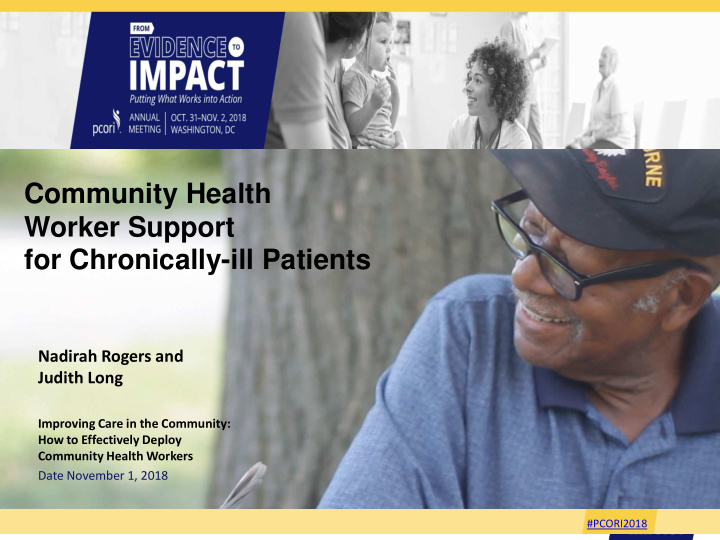



Community Health Worker Support for Chronically-ill Patients Nadirah Rogers and Judith Long Improving Care in the Community: How to Effectively Deploy Community Health Workers Date November 1, 2018 ‹#› • December 4, #PCORI2018 2018
Nadirah Rogers and Judith Long Disclosures: Patient-Centered Outcomes Research Institute (PCORI-1310-07292) 2 • November 1 , 2018
Objectives At the conclusion of this activity, the participant should be able to identify: • Ways a standardized intervention can provide tailored support • Key elements of a CHW intervention that enable efficacy • Tools and training to facilitate dissemination and scale of evidence-based interventions 3 • November 1, 2018
4 • November 1, 2018
5 • November 1, 2018
6 6 • November 1, 2018
Standardized work practices • Manuals for CHWs, managers and program directors 7 • November 1, 2018
Training & Certification Based on core competencies for each role Manager CHW Certification Director 8 • November 1, 2018
Technology Documentation, reporting and data infrastructure 9 • November 1, 2018
10 10 • November 1, 2018
Objective Determine, in a multi-center randomized controlled trial, whether 6 months of goal setting and CHW support leads to improved outcomes compared to goal setting alone. Sites: VAMC, FQHC, Academic HC 11 11 • November 1, 2018
Methods Participants: • Uninsured or publicly insured • Residents of high-poverty regions in Philadelphia • ≥2: hypertension, diabetes, obesity, tobacco dependence Outcomes assessed at 6, 9 months: • Self-rated physical health, mental health, chronic disease control, patient activation, quality of care, hospitalizations Analysis: • Intent-to-treat • Generalized estimating equations 12 12 • November 1, 2018
Intervention Adaptations (1-3 months): • Tailored communication, software and training • Separate CHWs at each site • Work privileges Core intervention: • 6 months of tailored support • Weekly contact and monthly face-to-face 13 • November 1, 2018
Participants (n=592) Age, years 52.6 African-American 94% Household Income < 15K 65% Trauma History 98% 14 • November 1, 2018
Patient Tailored Support CHW (also veteran) organized 65 year old socially isolated outings with other veterans: veteran with PTSD and bowling, movies, urban hypertension garden 32 year-old single mother with CHW advocated for patient to move to 1 st floor with a asthma living in moldy shelter basement window 15 • November 1, 2018
Outcomes blank Diff-in-Diff P value ∆Self -rated Physical Health -0.7 0.30 ∆Self -rated Mental Health 0.8 0.41 ∆Chronic disease control blank 0.21 -6.3 blank Systolic blood pressure (mmHg) Obesity (BMI) -0.2 blank -0.2 blank Diabetes (HbA1c%) Tobacco dependence (Cig per day) -0.5 blank ∆Patient Activation 1.9 0.06 Risk Diff P value blank 0.12 <0.001 Highest Quality (Comprehensiveness) Highest Quality (Supportive of Self-Management) 0.12 <0.001 16 16 • November 1, 2018
Total Hospital Days 17 • November 1, 2018
Hospitalizations Diff-in-Diff P value blank Mean Length of Stay -3.1 0.06 Risk Diff P value blank Repeat Admissions 0.4 0.02 30-d Readmission 0.3 0.04 18 • November 1, 2018
Dissemination http://chw.upenn.edu/ 19 • November 1, 2018
Veterans and IMPaCT vimeo.com This is "Veterans and IMPaCT" by Penn Center for CHWs https://vimeo.com/290342176 20 • November 1, 2018
21 • November 1, 2018
Participants (n=592) Age, years 52.6 African-American 94% Household Income < 15K 65% Trauma History 98% Baseline Chronic Disease Control Systolic Blood Pressure (mmHg) 161.6 Obesity (BMI) 42.5 Diabetes (HbA1c%) 10.5 Tobacco dependence (Cig per day) 9.3 22 • November 1, 2018
Limitations • Geographically limited Follow-up period was only 9 months • • Hospitalization data for veterans was limited to the VA network 23 • November 1, 2018
Recommend
More recommend